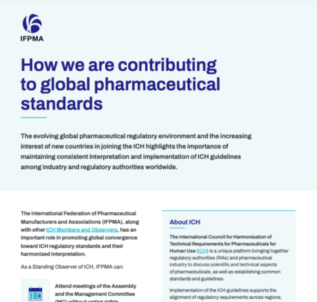2016 IFPMA General Assembly-Concluding remarks by Ian Read
Committed to a Healthier Future
2016 IFPMA General Assembly
30 November 2016
Concluding remarks by Ian Read
Incoming President, IFPMA,
Chairman of the Board and Chief Executive Officer, Pfizer
Good afternoon. I am delighted to be with you this afternoon.
I want to begin by thanking Stefan Oschmann for his outstanding leadership over the past two years in creating a more robust and vibrant IFPMA.
Under his guidance IFPMA has made notable progress towards achieving its’ mission “to advocate policies and practices that encourage the discovery of, and access to innovative quality medicines and vaccines for people everywhere.”
Specifically we can point to progress across each of the key focus areas within IFPMA’s strategic plan. More specifically:
Engagement with international and cross industry coalitions such as WIPO, WHO and WTO to reframe the IP and access debate to position IP as an enabler of access to medicines – not a barrier. And the establishment of principles for creating and nurturing innovation ecosystems.
Facilitated platforms for dialogue with the WHO and created new partnerships with groups like the Red Cross on major global health initiatives.
Instituted a framework for maintaining strong ethical standards across the industry, and
Created new programs to broaden the understanding of major risk factors for non-communicable diseases (NCDs).
I am honored to take on the Presidency of IFPMA. I look forward to working with the hardworking and dedicated IFPMA team to build on the culture of innovation, trust and sustainability that Stefan instilled, and working with Dr. Teshirogi, CEO Shionogi and Severin Schwan, CEO of the Roche Group.
While Stefan and I come from different professional backgrounds, I believe we both share the common belief that it takes novel partnerships to solve the complex problems facing the global health community.
Novel partnerships such as GAVI that uses market principles to deliver a sustainable vaccine supply to low income markets. Through this approach GAVI has exceeded many of its key mission targets for reducing child mortality rates specifically:[1]
- Going from 76/1000 in 2010 to 63/1000 in 2015, a 15% reduction,
- Averting future deaths (greater than 4 million in 2015)[2],
- And the number of children immunized (277 million in 2015)[3].
Another example that I am personally proud of involves my own company: the World Health Organization announced earlier this month that Morocco has eliminated trachoma as a public health problem within the country. This progress is the result of a WHO-led alliance that is a unique collaboration of more than 100 governments, non-governmental organizations and private sector partners.
Growing Burden of NCD’s in Developing Countries
One area of global health concern that both Stefan and I share is the large and growing burden of non-communicable diseases that is emerging in low and middle income countries.
To address this emerging need will take a multi-faceted approach where we draw upon:
- the success of partnership models like GAVI
- the industry’s collective commitment building on the London Declaration to control and eliminate Neglected Tropical Diseases and
- the U.N. Sustainable Development Goals particularly Health Goal #3 which seeks to “ensure healthy lives and promote well-being for all at all ages” and Goal 17 that relates to partnerships.
The rapid increase in NCD’s is having a significant impact on patients of all ages, their families and communities in which they live.
Left unchecked NCDs could overwhelm health budgets in the coming decade and reverse many positive global health trends.
There are several contributing factors leading to this increasing burden of NCDs in low and middle income countries. Chief among them:
- Ageing populations: which is partially due to our increasing success in treating infectious diseases and improving child vaccinations, enabling people in low and middle income countries to live longer and more productive lives, and
- An increase in risk factors due to the adoption of Western-style health behaviors and lifestyle choices, such as smoking, unhealthy diets, excessive use of salt, excessive consumption of alcohol and insufficient exercise.
And there is an economic cost to these NCD trends:
- A study conducted for the World Economic Forum estimates that under a “business as usual” scenario, low- and middle-income countries could lose $500 billion per year over the period 2011–2025 due to NCD morbidity and mortality: this equates to roughly 4% of average GDP for these countries.[4]
Add to this the fact that low and middle income countries have under-resourced health care systems with barriers that limit access to diagnosis, treatment and care.
The barriers include things such as inadequate healthcare financing, lack of effective new treatments, regulatory obstacles, lack of supply chain integrity and efficiency, lack of diagnostic facilities, and insufficient quality of care.
Tackling NCDs will not only save lives, we also know from past experience that investing in health creates a more productive workforce, fosters increased investment and raises living standards and economic conditions.
- One extra year of life expectancy raises a country’s per capita GDP by about 4 percent[5].
Role of Biopharma Industry
So what can our industry do to tackle this problem? I believe we will need to facilitate investments in health systems, which requires a comprehensive approach across all sectors of the healthcare system.
As Stefan mentioned in his opening remarks, the role of innovation in developing solutions to help low and middle income countries is crucial.
The private sector is a key player and has a lot to offer in the way of innovative solutions that also support the achievement of the U.N. Sustainable Development Goals, especially the goals I just mentioned: Goal 3 and Goal 17.
For example, through grant making and collaboration with NGOs, governments, and academic institutions, the industry is helping to achieve one of the targets of SDG Goal 3 of reducing premature mortality due to NCDs by one-third by 2030.
We will need to build on the IFPMA’s NCD framework that focuses on where the industry can add the most value.
Role of Government
While the private sector has an important role to play, governments also play a critically important role in prioritizing investment in healthcare infrastructure.
Today less than 6% of GDP is spent on healthcare in low and lower middle income countries (about $270 per capita). By contrast, high income countries spend more than 12% of their GDP (more than $5,000 per capita).[6]
One approach to ensure the right solutions are created is through the formation of novel partnerships between governments, the private sector, and NGOs to ensure the right investments are made to stem the impact of the growing NCD burden on health system budgets.
Through novel partnerships we can develop solutions that include:
- Innovative health finance and risk-pooling mechanisms;
- Remote training, development and health workforce retention solutions;
- Sustainable business models and tiered pricing strategies that help achieve better access to essential NCD medicines, diagnosis and prevention tools;
- Enhanced data collection, analysis and management to inform and shape health policies and investment decisions;
- Managing infrastructure and capital investments, including a secure and robust supply chain that ensures high quality medicines reach patients in need;
- Implementing mechanisms for governance and accountability;
- Development of a sound policy environment that includes legislative reform, health system strengthening, and regulatory harmonization;
- Implementation of new access programs that deliver comprehensive solutions with direct impact on patient outcomes for specific NCDs
To implement any of these solutions governments have to view investing in their health systems as a priority.
The IFPMA has an important role to play and is well positioned to inform the development of public policies that promote solutions to address NCDs while simultaneously enabling health systems to address the barriers that are preventing access to quality care for both communicable and chronic conditions alike.
We are poised to help drive these types of innovative partnerships with stakeholders across government agencies — health, finance, foreign affairs, and education.
In summary, coming back to where I started my remarks today…
To fulfill IFPMA’s mission will require advocating for solutions that embrace
- Innovative partnerships with governments where we can help them to better understand the value of investing in their health systems
- Market-Based Incentives that support the development of new medicines, and innovative solutions for health services and delivery
- Ways to ensure adequate coverage for everyone in the health system through investments in programs and resources
The need is clear and the industry will be announcing an effort with our partners at the World Economic Forum in January.
Thank you for your time and most importantly your work. The years ahead will be critical for the industry and I look forward to leading IFPMA to drive our strategic plan forward.
[1] Source: http://www.gavi.org/results/goal-level-indicators/mission-indicators/)
[2] Source: Gavi, the Vaccine Alliance/Bill & Melinda Gates Foundation 2016, http://www.gavi.org/about/mission/facts-and-figures/
[3] Source: WHO/UNICEF 2016, http://www.gavi.org/about/mission/facts-and-figures/
[4] (World Economic Forum and World Health Organization: From Burden to “Best Buys”: Reducing the Economic Impact of non-Communicable Diseases in low- and Middle-Income Countries. 2011, Geneva: World Economic Forum and World Health Organization)
[5] (Bloom, David E., David Canning, and Jaypee Sevilla, “The Effective of Health on Economic Growth: A Production Function Approach,” World Development, Vol 32, No 1., pp1-13, 2004)
[6] (Source: World Bank)
About IFPMA
The International Federation of Pharmaceutical Manufacturers and Associations (IFPMA) represents over 90 innovative pharmaceutical companies and associations around the world. Our industry’s almost three million employees discover, develop, and deliver medicines and vaccines that advance global health. Based in Geneva, IFPMA has official relations with the United Nations and contributes industry expertise to help the global health community improve the lives of people everywhere. For more information, visit ifpma.org.
Learn more





